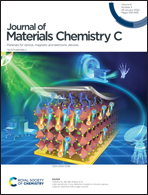Solution-processable black phosphorus nanosheets covalently modified with polyacrylonitrile for nonvolatile resistive random access memory†
Abstract
Nonvolatile resistive random access memory (RRAM) has demonstrated great potential for in-memory computing systems with greatly enhanced computation capability. By using BP-DDAT (DDAT: S-1-dodecyl-S′-(α,α′-dimethyl-α′′-aceticacid)trithiocarbonate) as a reversible addition and fragmentation chain transfer (RAFT) agent, a novel polyacrylonitrile covalently modified black phosphorus (BP) derivative (BP–PAN) has been successfully synthesized. The formation of a P–C bond between phosphorus and an aryl group bonded to the PAN polymer has been confirmed by XPS and FTIR measurements. The environmental stability of BP nanosheets is greatly improved by covalent functionalization with PAN. The as-fabricated Al/BP–PAN/ITO device shows very good nonvolatile rewritable RRAM performance with high ON/OFF current ratio exceeding 104, whereas the thermally annealed BP–PAN (i.e., pyro-BP–PAN)-based device did not display any information storage effect under the same measurement conditions. Pyrolytic modification of PAN leads to the formation of conjugated chain molecules by linking of nitrile groups, which decreased the electron-withdrawing capability of PAN in the structure of BP–PAN, thereby losing the switching and memory performance.



 Please wait while we load your content...
Please wait while we load your content...